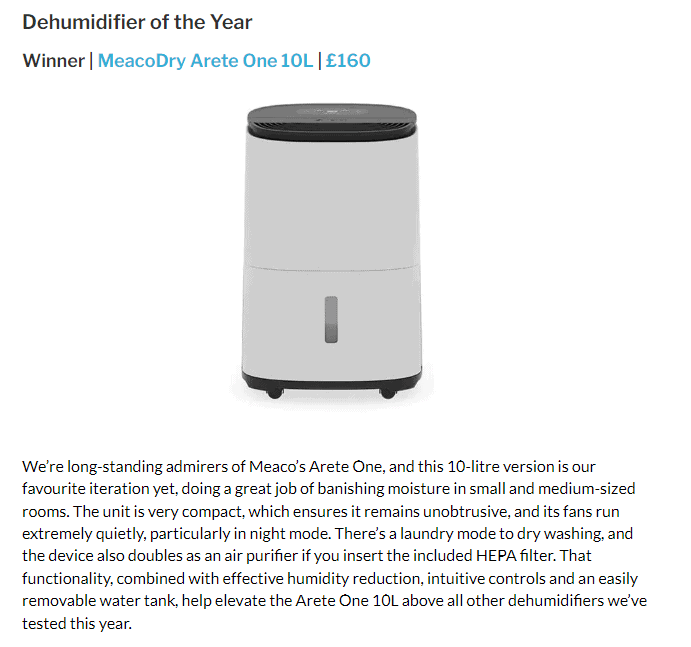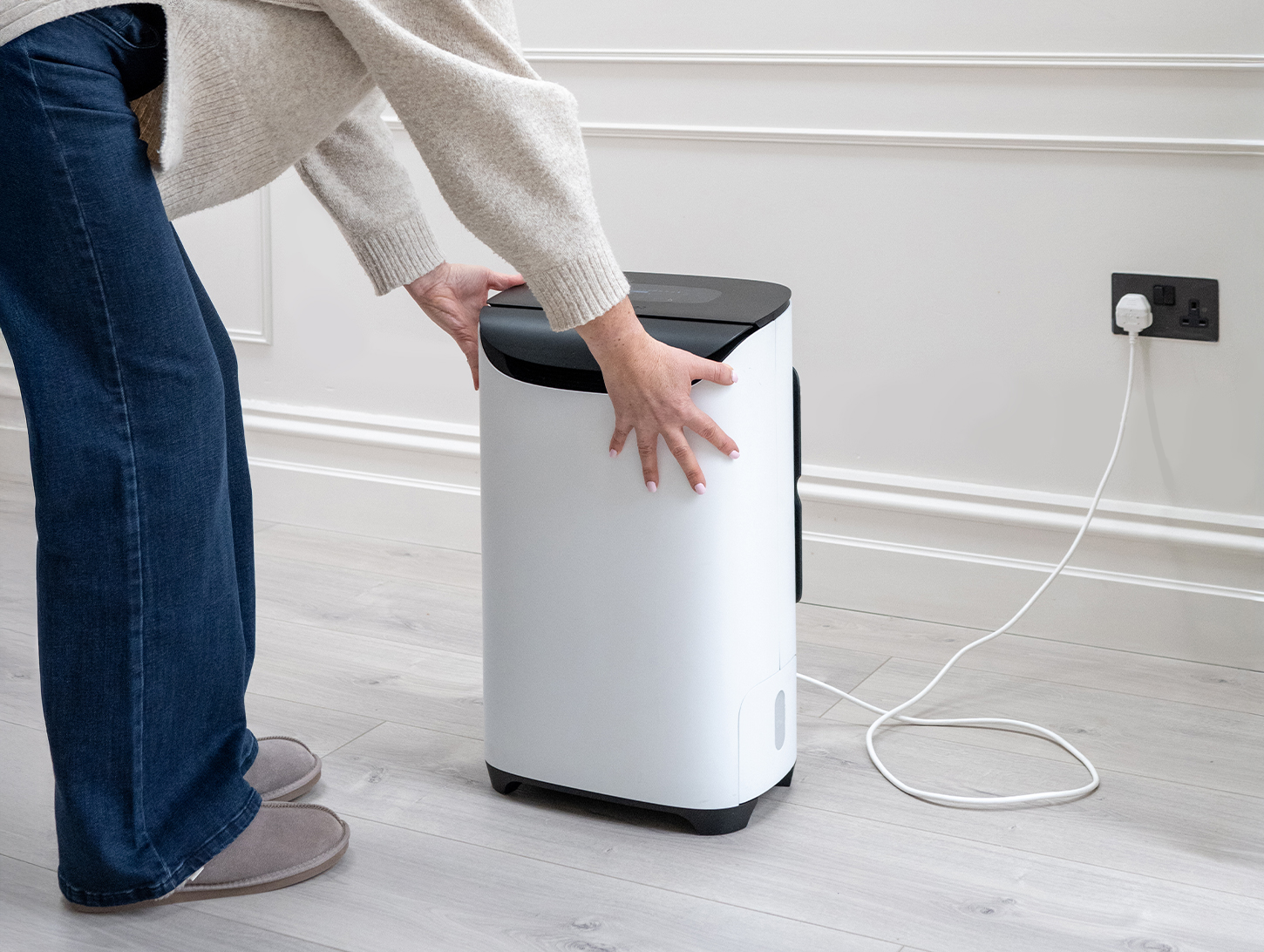Mould and condensation are often a cause for concern at this time of year, with more rainy and colder days our priority is to keep our homes warm and comfortable to live in. One way of preventing mould, condensation and damp inside your home is by using a dehumidifier, but with so many options on the market it’s important to make sure you are buying one that will not only help combat the problem of excess humidity, but which also has a long lifespan.
Before buying your dehumidifier, we recommend that you look for tell-tale signs of excess moisture in your home as there are always clear indicators of high humidity; for instance mould on walls, condensation on the windows, or musty smells to name a few.
Things to think about when choosing your dehumidifier:
How many rooms does your house have?
Firstly, you will have to understand the size of the house and which dehumidifier to use according to this – usually near the kitchen or just outside the bathroom with the door open are the more humid areas.
Will you want to move your dehumidifier around? If so, a dehumidifier with wheels is probably preferable. Are you using it in a small flat or home? A more compact dehumidifier would work for this, like our MeacoDry Arete 12L with its small, lightweight and compact design complete with castors.
When considering which dehumidifier to buy, you might want to think of the size of your house and read the specifications of the dehumidifier you want to buy (ours can be found in the instruction manual or on the technical overview tab on each product page).
Up to 2 bedroom flat/house | Up to 3 bedroom house | Up to 4 bedroom house | Up to 5 bedroom house or townhouse | |
Slightly damp 50%-60% relative humidity Light mould/condensation | 10L | 12L | 20L | 20L |
Moderately damp 60%-70% relative humidity Musty smells/regular mould/condensation | 12L | 12L | 20L | 25L |
Very damp 70%-80% relative humidity House always cold/mould & condensation in multiple rooms. Drying washing. | 12L | 20L | 25L | 25L x 2 |
Wet 80%-100% relative humidity Condensation on walls, mould on furniture/clothes. | 20L | 20L | 25L x 2 | 25L x 2 |
Energy efficiency
With high energy bills affecting us all these days, we are always looking for ways to reduce our electricity bills. When buying a dehumidifier, it’s important to consider the running cost over the initial price of the unit as it could save you a lot of money in the long term.
None of our products are energy draining products, in fact we have the most energy efficient range of dehumidifiers in Europe and we are proud to be leading the way in low energy dehumidifiers. That is why we encourage our customers to always look at all the technical information when buying any electrical product, as you could save yourself hundreds of pounds every year in energy consumption.
Read more about how buying a Meaco dehumidifier could save you over £700 in 5 years.
For Meaco, being transparent with our customers is our priority. We are more transparent than anyone else in the industry, that’s why the running costs are available for each model on the Technical Data tab on each product page. For more product specific details, please refer to the product page.
Will you be using your dehumidifier to dry your laundry?
Smaller flats or homes usually don’t have room for a tumble dryer, so the laundry tends to be hung to dry on a drying rack, the radiator or the back of chairs. In the colder months we keep our windows closed to prevent the heated air from escaping.
This results in the moisture from the clothes staying inside the home and the relative humidity starts to build up. Mould and condensation will then appear on cold surfaces around the home, on your windows or north facing walls.
If your flat or home doesn’t have an extractor fan in the bathroom or in the kitchen above the hob, the build up of humidity will be even worse.
Desiccant or compressor dehumidifier?
Another feature to consider when buying your dehumidifier is whether you want a desiccant or compressor dehumidifier. For a cold room (below 10°C) , you will want to buy a desiccant dehumidifier. For use in a warm room, the compressor dehumidifier is better for you.
Desiccant dehumidifiers are lighter and quieter in their low fan speed. They have a heater inside and they have a consistent performance regardless of the temperature; the air released from the desiccant dehumidifier is around 10-12°C warmer. So they are better if you’re using it in a cold hallway as they’ll warm the space up.
Compressor dehumidifiers work better in spaces that are already warm, above 10°C, if you are using a large compressor machine (20/25L) or above 16°C for a smaller compressor dehumidifier (10/12L). If you’re using it in a room that’s already nice and warm, the compressor is the best and will release air that is around 2°C warmer and will use less energy.
Look for customer reviews or press reviews
As with all purchases, it’s always best to have a look at reviews written by other customers or articles by press reviews or other product testing companies. Not only will they reveal the benefits of using the product, but it might also help give an idea on where to use it.
We are very proud to have won many awards for our dehumidifiers, notably Which?, Good Housekeeping Institute and QuietMark, but the great feedback that we receive on a daily basis about our dehumidifiers and the support from our customer support team. Reviews will always give you a more objective opinion and more detailed idea of your product. Our reviews can be found under ‘reviews’ on the product pages.
Have a look at one of our recent press reviews of our MeacoDry Arete from Expert Reviews (which won dehumidifier of the year!).








94 responses
Hi Chris
We live in a 4 bed Victorian mid terrace property (1895). It’s approx 150sq mtrs. Ground floor is main lounge, snug, hall, downstairs loo, kitchen and utility to rear where the washing machine and tumble dryer (condensing heat pump type) are located. We only use the tumble dryer and do not have wet clothes about the house trying to dry. We suffer from a little bit of condensation on the lounge bay windows(it’s north east facing) and sometimes on the kitchen and utility room.
Upstairs we have the 4 bedrooms and a bathroom. The main bedroom and back bedroom (above the utility) have terrible condensation with water literally pouring down the windows and occasionally even the wall of the back bedroom (southwest facing). Mould on the upvc frames if left unchecked and bathroom windows and ceiling. There is no extraction in bathroom so open windows when possible to ventilate.
Do you think we’d need the 25l Arête over any other model and where would be the best location to ensure full house air flow? I’ve also been looking at Positive Input Ventilation but don’t really want to introduce cold winter air into the house.
Thanks for your help and recommendations.
Cheers
Paul
Paul,
I would put the arete on the landing to capture the moisture before it gets to the bedrooms and make sure that you use extractor fans in the bathroom(s) or open the windows after you bath or shower. You are right about the PIV systems, they will drive up your heating bill and bring in colder air.
Chris
Thanks Chris.
I’ve ordered the 25L and will come back with the results as soon as I can
Looking forward to improved air quality and less condensation/damp/mould.
Hi,
I live in a 3 bed flat (5 rooms in total) split on two floors by a small staircase (about 5 steps), the main body of the flat is 50 sq meters but there is also a downstairs section that’s just a very small area where the front door is (180cm x 75cm) and a long staircase that leads to the main body of the flat. I hope that makes sense. There are two of us living in the flat.
The flat is quite old, not insulated and has been very cold over winter. I am having issues with clothes taking a very long time to dry, condensation on all the windows and mould forming on some of the walls in the corridor and also on the ceiling and in the cabinet in the bathroom. I think my extraction fan is not quite up to the job.
I’m not sure if I should get the Arete 20L or 25L, what would you recommend?
Also do you know when stock will be available in John Lewis or Argos?
Thanks very much!
I would sort it with a 25L. John Lewis will receive a batch on the 4th and Argos will receive a load on the 6th.
Hi Chris,
Thanks for your response. I was just reading some more and I realised perhaps I should be getting a desiccant humidifier, I’m not sure exactly how cold the flat gets but it might be 10 degrees or less often without heating. What would be the best desiccant humidifier for the whole flat?
Thank you
It is probably unlikely that the flat is below 10°c for long, especially if you are not on the ground floor. Humans tend to feel the cold indoors below 15°C, so you are probably ok.
Hi Chris,
I ended up getting a room thermometer with a humidity gauge to check and it’s been consistently 6-10 degrees without the heating on, rising to 15 degrees after the heating has been on for a couple of hours. Humidity has been always 60-80%.
If you are going to let it remain under 10°C for long periods then it has to be a DD8L (available from the 4th Feb on meaco.com), but if it is more above 10°C then go for the cheaper to run Arete 20L.
Hi
I have a 3 bedroom house and have a problem with condensation, mould and damp in some areas of the house. I want to get a dehumidifier and was looking at the 20l arete. Would 20l be sufficient and where is the best place to situate it in the house? The condensation is mainly a problem upstairs causing some Mould on the walls and then some areas downstairs. Thank you
The Arete 20L will be fine. Put it closest to the sources of moisture, so use it to dry washing and if you have a bathroom with no extractor fan then put it outside there on the landing.
Hi
Please can you advise me? I live in a three bedroom semi-detached bungalow with a conservatory. I do not normally have a condensation problem – just a little on the windows after a particularly cold night. I would like a dehumidifier which would also help dry washing efficiently in a spare small bedroom. . I live on my own currently. Which would be the most energy efficient and suitable dehumidifier for my needs please? I am attracted by the 5 year guarantee of your arête models. Many thanks.
Maggie,
As it is just yourself, go for the Arete 10L, it is available now on this website.
Chris
Hi Chris,
We are in a two bed house with a conservatory. Without heating, the humidity can go up to 67%. There are condensation and mould developing in window frames, ceiling and walls from our conservatory, first floor bedroom and bathroom. So we desperately need a dehumidifier. Have been looking at Arete or the Low Energy ones as we want the HEPA filter for my allergy. Should we go for the 20L or less is fine?
Also, we are wondering whether we should buy a separate small desiccant dehumidifier for the conservatory alone. Or would the 20L be enough to cover all on both floors.
Thanks,
Thanos
Thanos,
I would guess that the door to the conservatory is mostly closed at this time of year? If this is the case it will need it’s own desiccant dehumidifier because the air will not flow around the house. It has to be a desiccant because the temperature in there will be so low overnight. The DD8L Junior is suitable and is in stock on this website. For the rest of the house go for an Arete 20L to get the job done properly and quickly. Use it to dry any washing that is dried in the house.
Chris
Thanks Chris for your quick reply.
In fact, the conservatory is extended from the kitchen with nothing to separate the air flow. So we are just using the door on the other end of the kitchen to separate it with the main hallway. So would you still suggest the same? Thanks.
Looking for stock of your 20L dehumidifier but none available. Tried John Lewis who advised by email that stock available but sold out within the hour. Also have alert set up on your site before Christmas but nothing heard. How do we purchase this product without constantly visiting web sites? Is it possible to place an order which will be fulfilled as soon as you receive stock?
Phil,
Sorry about that, demand is crazy. Appliances Direct have stock today as well, there will be loads of stock in the system at the end of next week.
Chris
Hi. Do I need a 20L or 25L humidifier?
I have an apartment with a small entrance lobby with cold and mouldly. A staircase leads upstairs to the next level with 3 beds, 2 bathrooms, open plan kitchen/dining/sitting areas. Two adults live here. The loft now has condensation and mould forming, the bedrooms North facing have condensation and cold walls. Will the machine cope placed in apartment at top of stairs, with loft hatch open to clear all humidity? Advice please. Many thanks
That sounds like a good plan. Go for the Arete 25L. John Lewis get stock at the end of this week.
ventilate after using the bathroom and when you cook in the kitchen. If you are drying washing indoors then use the dehumidifier to dry the laundry. Otherwise set the machine to 50%rh and let it run whenever it needs to.
Hi Chris
I bought the meaco Arete 12L – I left it running in the kitchen for a week the humidity went from 88 to 75% and struggles to get below this. Only 450ml of water were collected in one week. Is this normal?! The temp tends to be around 11 degrees in the kitchen.
I also used the laundry mode in a room that’s 25m2 overnight when the temp was around 15 degrees – there was no water collected in the tank at all in the morning.
Is there anything else I can do to maximise use of this dehumidifier or is this the way it tends to work in cooler temperatures??
Bringing the temperature in the kitchen to above 16°C will help a huge amount. On the laundry mode point if the relative humidity on the display was already low (in the 30s), then you would not get any water. Please make sure that the filter is clean as well.
Hi, I am looking to buy a dehumidifier for a 68 m2 unheated garage. Is the Meaco DDL8L Zambezi suitable for this and how does it differ from the Meaco DD8L Junior ? Temperature in the garage fluctuates between 7 and 13 degrees, is a desiccant dehumidifier recommended or what is your advice ? Thanks
At those temperatures it should be desiccant and either machine would be fine, the Junior is in stock at the moment. Zambezi just gives you more bells an whistles, but both will do the job.
Hi Chris,
thanks for your reply.
Other questions : what is the lifespan of a desiccant dehumidifier? Does the rotation wheel have to be replaced after x amount of time ? And what is the type of desiccant used in the Meaco dehumidifiers ?
Kind regards Johnny
The zeolite desiccant wheel will last far longer than the rest of the machine and will not need to be replaced. It is a Japanese formulation that is regenerated internally by the heater.
Hi when is there more stock of the Meaco one 20L Arete no stock anywhere been like it since Christmas thanks
Thousands arrive every couple of weeks, but they do sell fast at the moment. Ourselves, John Lewis, Currys, Argos, BuyItDirect and BigOnElectricals are the places to keep an eye out.
Two of us live in a one-bed flat. The kitchen and bathroom are north-facing, but the bedroom and sitting room are warmer as they are south-facing. All the windows have condensation on a Winter’s morning, but bedroom less so due to open air vent at night. The kitchen is worse due to cooking there and mould builds around the window and some on the ceiling/wall. There is no heating in the bedroom (12°c), bathroom (10° – 12°c) and kitchen (10° – 12°c in Winter), but small fan heaters are used when cooking or showering, as well as window opened. No extractor fans or cooker hood. The living room is heated to 17°c -18°c. Washing is mostly dried in the garden, only occasionally indoors. Would be helpful to dry more indoors in Winter though. Which humidifier do you recommend, dessicant or compressor and which size? Thank you.
Has to be either a 20 or 25L Arete (25 would be better). Stock will be in Argos tomorrow.
Hi Chris,
We live in a small 2 bed house (2 people – 73swm), with a converted loft used as an office once a week. Without heating, temperatures rarely drop below 12C overnight in the winter (even during this recent spell of -5C temperatures outside). However we do also dry our laundry indoors, and some of the window frames are old aluminium – which develop quite a bit of condensation overnight in winter. There are no issues with mould/damps on the walls thankfully. We may also move to a 2 bed flat in a year or so, therefore I’m quite keen on the ABC 12L. Do you think this model will work well in the house?
Thanks in advance for your advice
Yes, that model will be fine.
Hi, best dehumidifier for a 5 bedroom detached house (10 year old ‘new build’, no evidence of damp or mould)? Loft conversion last year and this year struggling with a lot of condensation in rooms used as bedrooms and relative humidity in loft room of 60 to 65%, but only 40 to 50% in living room. Loft room typically 15 to 16 degrees (sometimes 14), rest of house is about 18 to 19 degrees. Laundry sometimes dried in house. What would you recommend as a good cost effective option? Thanks
Go for an Arete 20 or 25L dehumidifier, and use it to dry the laundry as well. This would be the best solution.